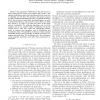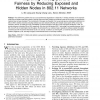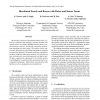856 search results - page 75 / 172 » Markov-based modeling of wireless local area networks |
INFOCOM
2007
IEEE
14 years 3 months ago
2007
IEEE
— The popularity of IEEE 802.11 WLANs has led to dense deployments in urban areas. High density leads to suboptimal performance unless the interfering networks learn how to optim...
SAMOS
2007
Springer
14 years 2 months ago
2007
Springer
For most applications in wireless sensor networks (WSNs), it is often assumed that the deployment of sensor nodes is unmanaged and random, so the density of local node may vary thr...
TMC
2008
13 years 8 months ago
2008
Abstract--Two well-known problems that can cause performance degradations in IEEE 802.11 wireless networks are the exposednode (EN) and hidden-node (HN) problems. Although there ha...
COMCOM
2010
13 years 9 months ago
2010
For data-collection applications in sensor networks, it is important to ensure base station receives a complete picture about the monitored area. Convergecast is an important commu...
FSR
2003
Springer
14 years 2 months ago
2003
Springer
We develop a network of distributed mobile sensor systems as a solution to the emergency response problem. The mobile sensors are inside a building and they form a connected ad-ho...



